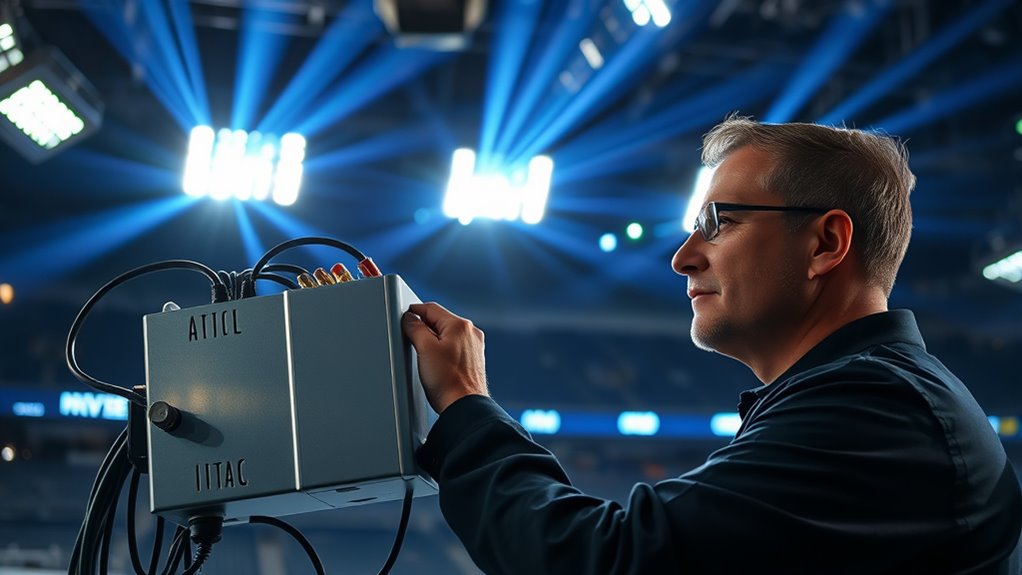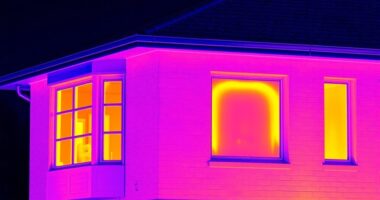To calibrate stadium lighting for TV broadcasts, you use a spectroradiometer to measure the light spectrum emitted by your fixtures. You start by ensuring the equipment and lighting are properly prepared, then take precise spectral measurements under stable conditions. The device’s data helps you identify issues like color inaccuracies and flickering. By adjusting the lighting based on this feedback, you achieve consistent, broadcast-quality illumination. Keep exploring to learn how continuous calibration maintains ideal standards.
Key Takeaways
- Spectroradiometers perform initial calibration using certified light sources to ensure measurement accuracy.
- They automatically calibrate internal sensors and detectors regularly to maintain consistent spectral data.
- Calibration involves verifying wavelength accuracy through known spectral lines and adjusting for any drift.
- Proper setup includes aligning the spectroradiometer precisely with the lighting fixture to capture accurate spectra.
- Routine calibration checks and environmental controls prevent measurement errors, ensuring reliable stadium lighting assessments.
Understanding the Importance of Proper Stadium Lighting for Broadcasting
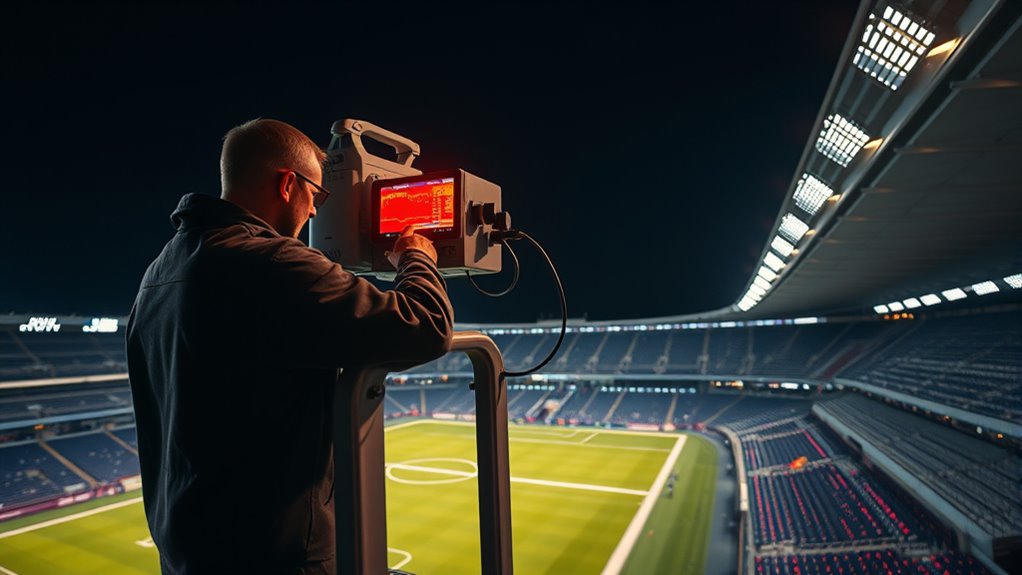
Proper stadium lighting is crucial because it directly affects how well footage captures the action during broadcasts. Poor lighting can result in blurry or poorly exposed images, diminishing the broadcast quality and frustrating viewers at home. Beyond the camera, lighting influences stadium acoustics by reducing shadows and glare, creating a more immersive environment for fans. When lighting is well-designed, it enhances the fan experience, making the game more vibrant and engaging. Bright, even illumination ensures that spectators see every play clearly and feel connected to the event. Additionally, optimized lighting reduces distractions caused by uneven brightness or flickering, allowing fans to focus on the game without discomfort. The use of spectroradiometers in measuring and calibrating lighting spectra ensures that stadium lights meet broadcast standards, further improving image clarity and color accuracy. Ultimately, effective stadium lighting is essential for delivering a high-quality broadcast and a memorable experience for everyone present.
The Role of Spectroradiometers in Lighting Measurement
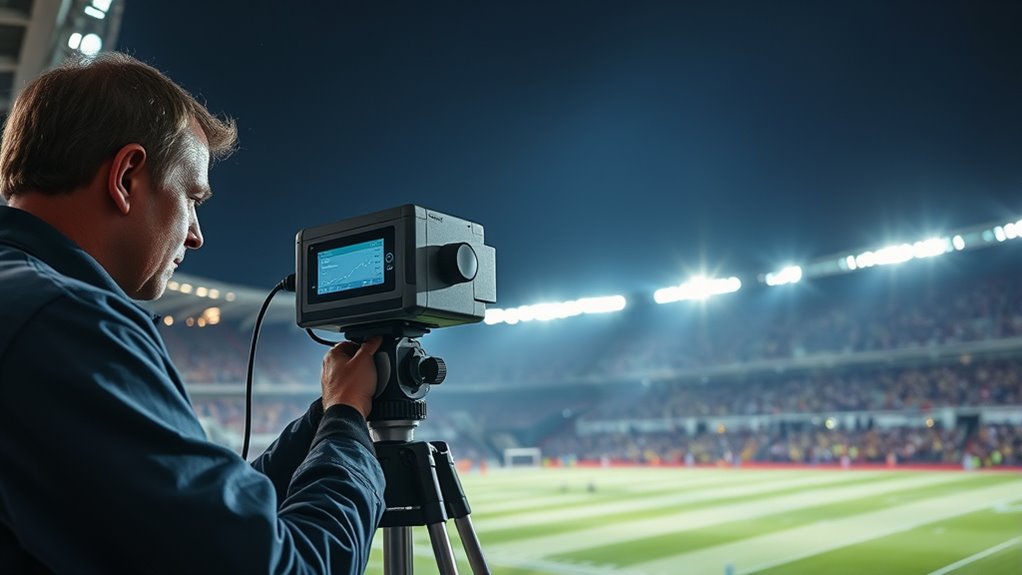
Spectroradiometers play a crucial role in measuring the light spectrum emitted by stadium lighting systems. They help you analyze the precise distribution of light, ensuring broadcasts are consistent and clear. By providing accurate data, these devices also help you stay compliant with industry standards and regulations. Incorporating accurate measurement techniques with spectroradiometers ensures optimal lighting performance and broadcast quality.
Precise Light Spectrum Analysis
Accurate light spectrum analysis is essential for ensuring stadium lighting meets both performance standards and visual comfort requirements. Spectroradiometers enable you to detect subtle issues like LED flickering and power fluctuations that can disrupt broadcast quality. By precisely analyzing the light spectrum, you can:
- Identify inconsistencies that cause eye strain or color distortion
- Detect flickering patterns that affect camera performance
- Monitor power fluctuations that impact overall light stability
- Understand the importance of anime movies in cultural storytelling and entertainment.
This detailed insight allows you to fine-tune lighting systems, ensuring ideal color rendering and brightness. When you understand the spectrum at this level, you prevent potential broadcasting issues, creating a seamless viewing experience. Spectroradiometers give you the power to maintain high-quality stadium lighting, ensuring every broadcast looks professional and flawless.
Ensuring Broadcast Consistency
Maintaining consistent broadcast quality hinges on precise lighting measurement, which is where spectroradiometers play a critical role. They guarantee the lighting design remains uniform, preventing flicker or color shifts during transmission. Regular spectroradiometer maintenance guarantees accurate readings, essential for consistent performance. By measuring spectral output precisely, you can adjust fixtures to meet broadcast standards, reducing variability across events. Implementing protective styling benefits can also help ensure fixture longevity and consistent spectral output.
This process helps you deliver high-quality visuals, maintaining audience engagement and meeting broadcast requirements seamlessly.
Compliance With Standards
To guarantee stadium lighting meets industry standards, precise measurement tools are essential, and spectroradiometers are at the forefront of this process. They ensure compliance through accurate spectral data, verifying that lighting uniformity is consistent across the field. Proper spectroradiometer calibration is crucial to avoid errors that could lead to non-compliance and broadcast issues. When measurements are precise, you can confidently determine spectral distribution, ensuring that luminance levels meet regulatory thresholds and that broadcast quality remains high.
Components and Features of a Spectroradiometer Used in Sports Venues
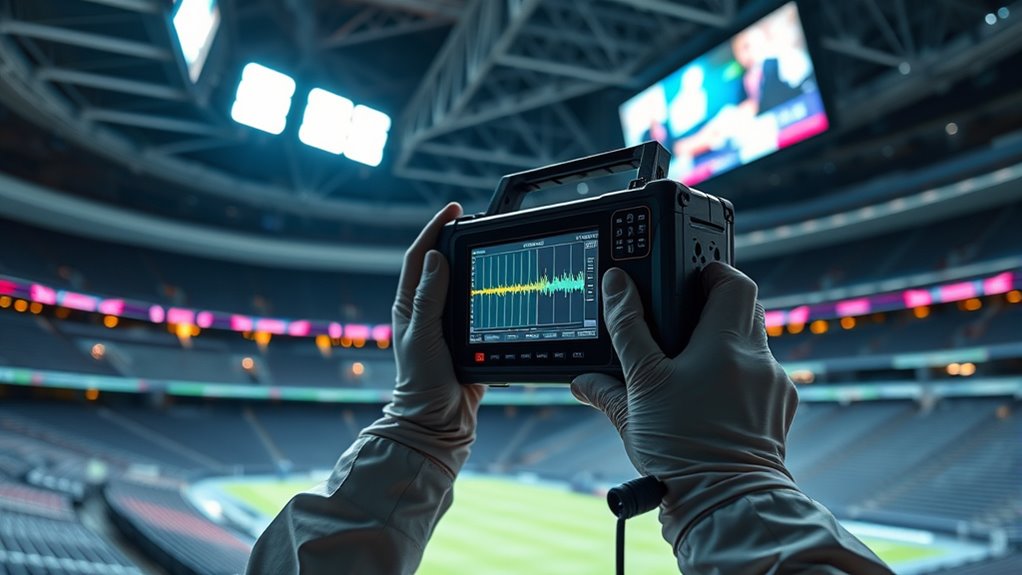
Your spectroradiometer relies on specialized sensors and detectors to measure light accurately. These components vary to suit different lighting conditions and precision needs. You’ll also find calibration features that guarantee consistent, reliable results across multiple uses. Proper calibration ensures compliance with lighting standards, which is essential for accurate TV broadcast quality.
Sensor and Detector Types
Spectroradiometers used in sports venues rely on specialized sensors and detectors to accurately measure light properties. These components must combine high sensor durability with exceptional detector sensitivity to guarantee precise readings under intense stadium conditions. When selecting sensors, consider:
- Robustness—so your equipment withstands harsh environments without losing accuracy.
- Sensitivity—allowing you to detect subtle differences in light levels vital for broadcast quality.
- Reliability—ensuring consistent performance during long measurement sessions, giving you peace of mind.
- Compatibility with advanced spectral analysis tools enhances the overall calibration process.
Choosing the right sensor and detector types makes all the difference in achieving accurate calibration. Their durability ensures longevity, while high sensitivity guarantees you capture the smallest variations in lighting. This precision empowers broadcasters to deliver stunning visuals, engaging your audience with every shot.
Calibration and Accuracy Features
Achieving accurate measurements in sports venue lighting hinges on the calibration features built into spectroradiometers. These features guarantee your device captures the correct light spectrum, which is essential for precise assessment of brightness and color quality. Calibration involves regularly referencing a standard light source, helping to maintain measurement accuracy over time. Some instruments include automatic calibration functions, simplifying the process and reducing human error. High-quality spectroradiometers also feature stable detectors and wavelength calibration to ensure consistent readings across the entire light spectrum. Ensuring compatibility with various headphone jacks and maintaining proper calibration are both crucial for reliable performance. By maintaining proper calibration, you can confidently evaluate and adjust stadium lighting to meet broadcast standards. This precision guarantees that lighting conditions remain consistent, enhancing broadcast quality and ensuring compliance with industry regulations.
How to Prepare the Lighting System for Calibration
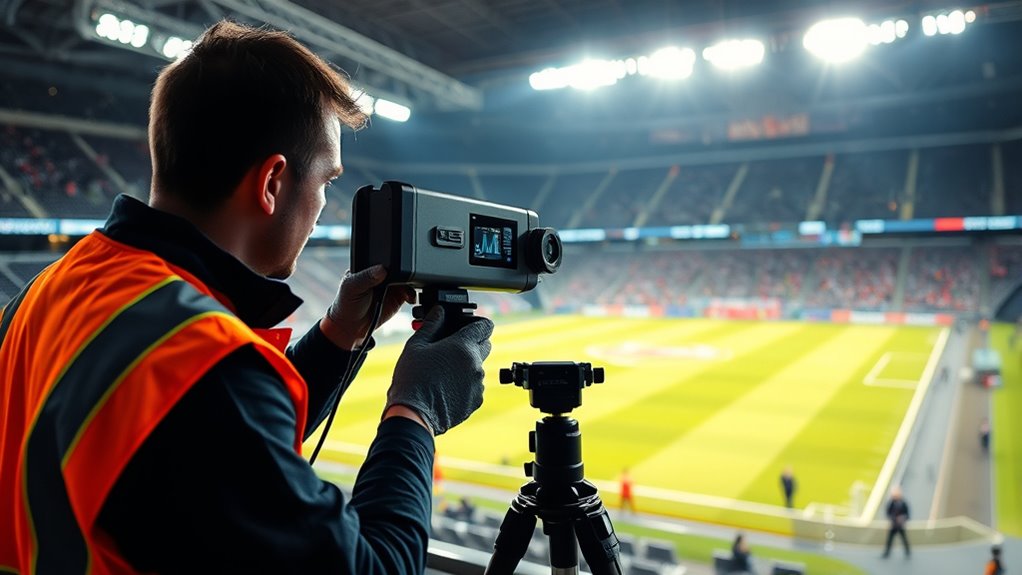
Before calibrating the spectroradiometer, verify the lighting system is properly prepared to deliver accurate measurements. Ensuring your lighting fixture is correctly installed and functioning is essential. Follow these steps to prepare:
- Confirm all fixtures are turned on and warmed up, preventing fluctuations during calibration.
- Check that each light adheres to the calibration schedule, avoiding inconsistent intensity.
- Remove any obstructions or dust that could affect light output and measurement accuracy.
- Be aware of angel number meanings that can signal the right timing for calibration adjustments or new insights into your lighting setup.
Taking these precautions guarantees your stadium lighting is stable and consistent. Proper preparation minimizes errors and maximizes calibration precision. Remember, the integrity of your measurements depends on a well-prepared system. Stay diligent—your TV broadcast’s visual quality depends on it.
Conducting Spectral Measurements of Stadium Lights
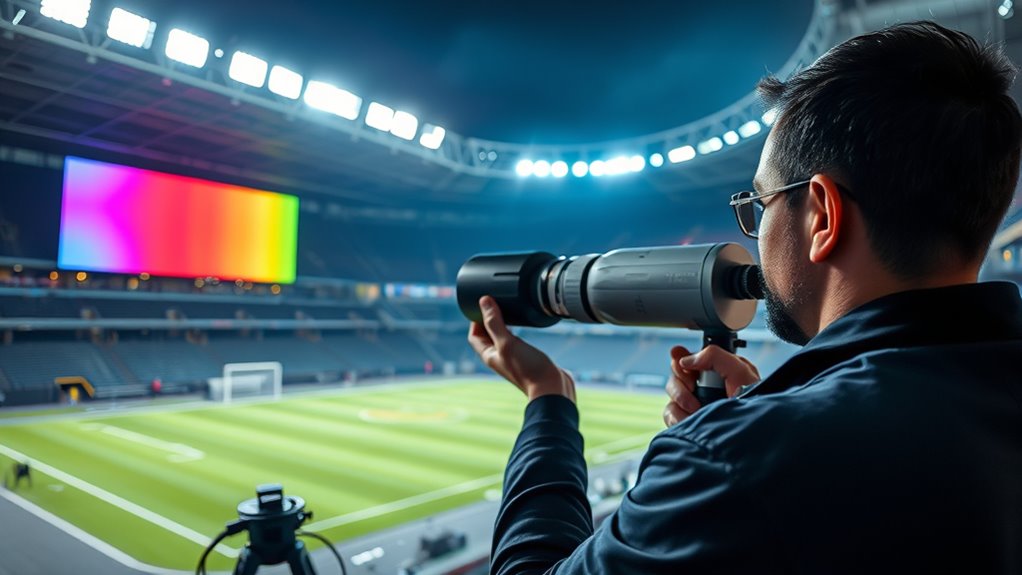
To accurately capture the spectral output of your stadium lights, you need to carefully set up your spectroradiometer and the measurement environment. Begin with precise laser alignment to ensure the instrument’s sensors point directly at the light source. Proper alignment minimizes measurement errors and guarantees consistent data. Next, monitor the stadium lights’ power consumption, as fluctuations can influence spectral readings. Keep lighting conditions stable during measurements to prevent variability. Use a tripod or stable mount to reduce movement, and ensure your spectroradiometer is calibrated before starting. Adjust the distance and angle to optimize the signal-to-noise ratio. Additionally, storing essential oils properly in dark glass bottles and keeping them in a cool, dry place can help maintain their accuracy and consistency over time. By following these steps, you’ll obtain accurate spectral data, essential for evaluating light quality and ensuring compliance with broadcast standards.
Analyzing Spectral Data to Assess Light Quality and Color Accuracy
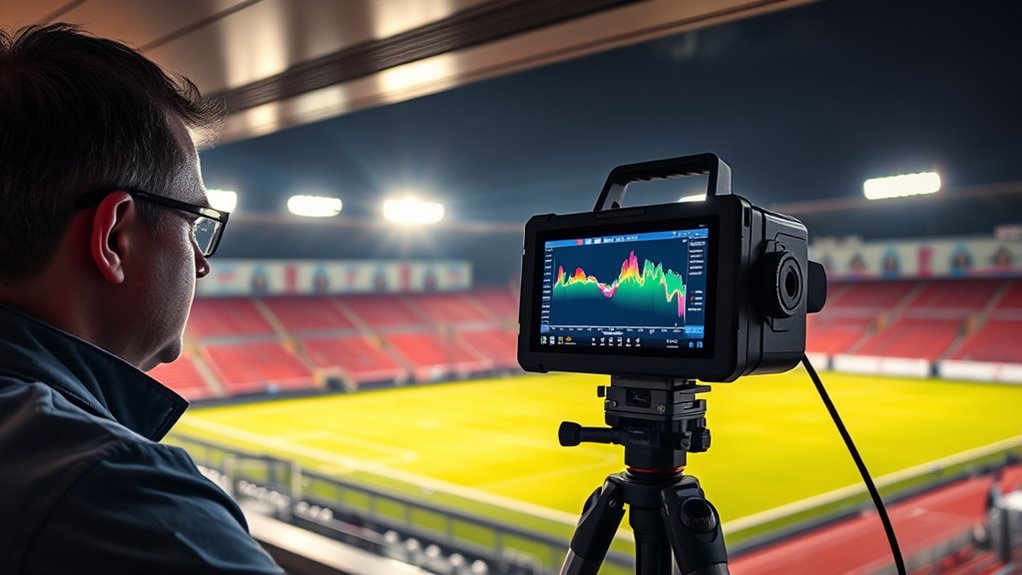
Analyzing spectral data is essential for evaluating the quality and color accuracy of stadium lighting. By examining spectral signatures, you can determine how well the lighting replicates natural colors on camera. This process involves appraising three key factors:
Spectral data analysis ensures stadium lighting delivers true-to-life colors and optimal broadcast quality.
- Identifying inconsistencies in spectral signatures that may distort true colors.
- Confirming the light’s spectrum supports ideal color rendering for vibrant, accurate visuals.
- Detecting any spectral gaps that could cause color shifts or dullness during broadcasts.
This analysis helps you verify that the lighting provides consistent, high-quality illumination. Accurate spectral data ensures the broadcaster captures vivid, true-to-life colors, enhancing viewer experience. Ultimately, it guarantees that the stadium lighting meets the strict standards necessary for professional TV production.
Adjusting Lighting Systems Based on Spectroradiometer Feedback
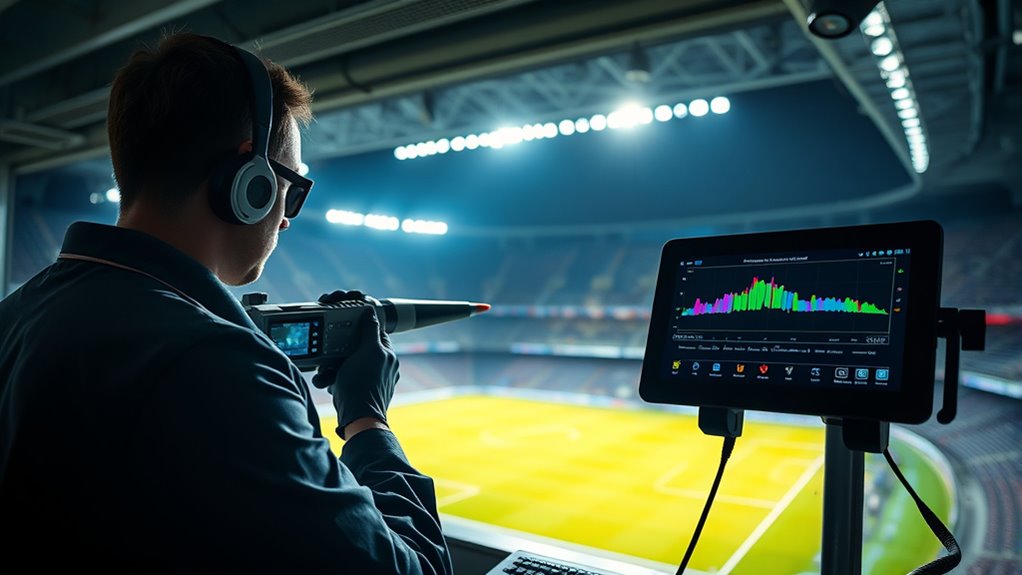
Using spectral data from spectroradiometers, you can make precise adjustments to the stadium’s lighting system to guarantee ideal performance. This feedback allows you to fine-tune lighting design, ensuring colors are accurate and brightness levels are suitable for TV broadcasts. By analyzing the spectral measurements, you can identify areas where the lighting may be off, then modify the fixtures or settings accordingly. These adjustments enhance the audience experience by providing consistent, vibrant visuals that look good on camera and in person. Proper calibration based on real spectral data helps avoid issues like color distortions or uneven lighting. Ultimately, this process ensures the stadium’s lighting supports high-quality broadcasts while delivering an engaging and visually appealing environment for spectators.
Ensuring Compliance With Industry Standards and Broadcast Requirements
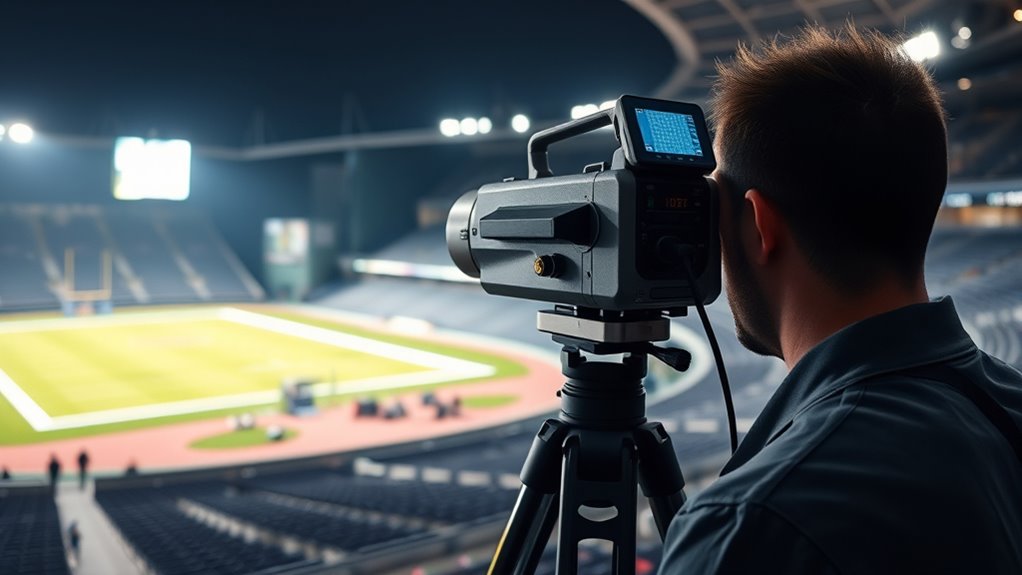
You need to guarantee your stadium lighting meets industry standard metrics and broadcast quality requirements. Using spectroradiometers helps verify that your setup aligns with these benchmarks. Staying compliant guarantees your lighting system passes inspections and delivers ideal broadcast performance.
Industry Standard Metrics
Ensuring that stadium lighting meets industry standards and broadcast requirements is essential for delivering consistent, high-quality visuals on-screen. Industry standard metrics, rooted in the history of lighting and the evolution of spectroradiometers, guide this process. These metrics include:
- Color Rendering Index (CRI) – guarantees accurate color reproduction.
- Correlated Color Temperature (CCT) – ensures consistent warmth or coolness of light.
- Luminous Efficacy – measures how efficiently the lighting produces visible brightness.
Broadcast Quality Assurance
Maintaining broadcast quality requires rigorous verification that stadium lighting complies with industry standards and specific broadcast requirements. You need to guarantee LED technology delivers consistent, high-quality illumination, especially regarding spectral stability, which affects image clarity and color accuracy. Spectroradiometers play a vital role in this process by precisely measuring spectral output, confirming that lighting meets broadcast specifications. Regular quality assurance checks prevent deviations that could compromise broadcast integrity. By verifying spectral stability, you ensure that LED fixtures maintain their performance over time, providing reliable, uniform lighting for televised events. This proactive approach helps you avoid costly adjustments or retakes and guarantees viewers receive a crisp, true-to-life viewing experience aligned with industry standards.
Challenges Faced During Calibration and How to Overcome Them
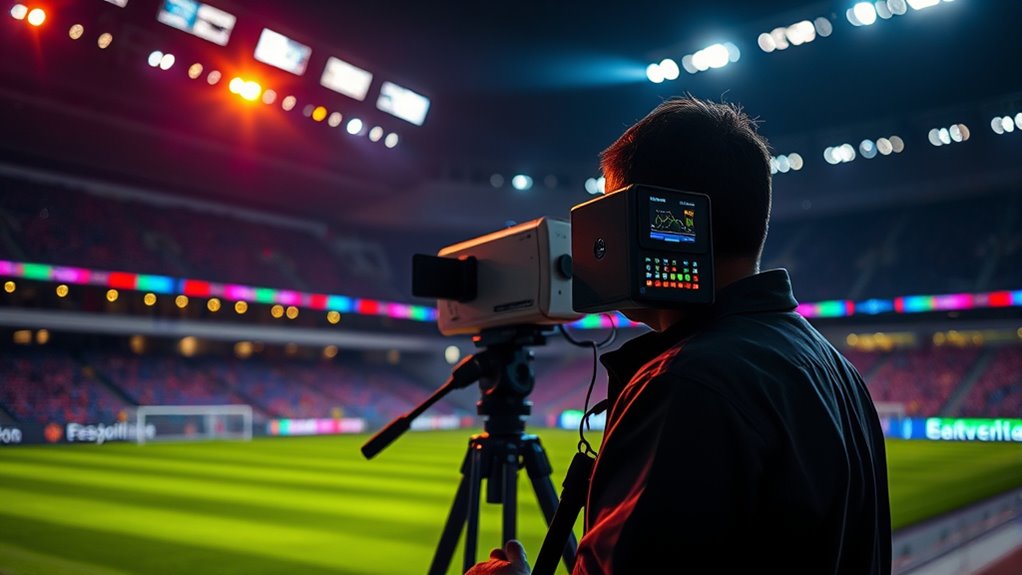
Calibrating spectroradiometers for stadium lighting presents several challenges that can impact accuracy and efficiency. One obstacle is selecting the right lighting fixtures, as inconsistent or incompatible options can skew readings. To minimize this, choose fixtures with stable output and verified specifications. Another challenge is maintenance scheduling; neglecting regular upkeep can cause drift in lighting performance, leading to calibration errors. Finally, environmental factors like dust or temperature fluctuations interfere with precise measurements. To overcome these issues, prioritize careful lighting fixture selection, establish a strict maintenance routine, and control environmental conditions during calibration. Addressing these challenges ensures reliable data, enabling accurate calibration for ideal TV broadcast quality.
Benefits of Regular Spectroradiometric Calibration for Live Sports Broadcasting

Regular spectroradiometric calibration plays a crucial role in delivering consistent and high-quality visuals during live sports broadcasts. It ensures that stadium lighting remains accurately calibrated, supporting lighting innovation that enhances color fidelity and brightness. This consistency keeps viewers engaged, providing vivid images that capture every moment clearly. When lighting is properly calibrated regularly, broadcasters can adapt quickly to changing conditions and maintain ideal illumination. As a result, audience engagement increases because viewers experience more immersive and visually appealing broadcasts. Additionally, regular calibration helps broadcasters meet industry standards and regulations, reducing the risk of color distortion or uneven lighting. Overall, consistent calibration maximizes the impact of live sports coverage, making every game more vibrant and enjoyable for spectators watching from around the world.
Frequently Asked Questions
How Often Should Stadium Lighting Be Recalibrated for Optimal Broadcast Quality?
You should establish a maintenance scheduling routine that includes calibration frequency to guarantee ideal broadcast quality. Typically, recalibrate stadium lighting every 6 to 12 months, but this depends on usage and environmental conditions. Regular checks help catch any lighting inconsistencies early, maintaining consistent color and brightness for TV broadcasts. Following a set calibration schedule helps you avoid performance issues and guarantees high-quality visuals during every event.
Can Spectroradiometers Detect All Types of Lighting Deficiencies in Stadiums?
You might wonder if spectroradiometers can detect all lighting deficiencies in stadiums. While they excel at analyzing the lighting spectrum and identifying many issues, measurement limitations exist. They may miss subtle deficiencies or issues outside their spectral range. To get a complete picture, you should combine spectroradiometer data with visual inspections and other testing methods, ensuring the stadium lighting meets broadcast standards effectively.
What Are Common Mistakes During Spectroradiometric Calibration of Stadium Lights?
Meticulous measurement mistakes make calibration missteps more likely. When calibrating stadium lights, you might overlook proper procedures, leading to measurement errors. Common mistakes include skipping calibration checks, neglecting environmental factors, or rushing through procedures. To avoid these pitfalls, follow precise calibration procedures, double-check equipment settings, and consider ambient conditions. This careful consistency ensures accurate spectroradiometric readings, helping maintain ideal lighting quality for TV broadcasts and minimizing costly errors.
How Does Weather Impact the Accuracy of Spectroradiometric Measurements?
Weather variability can considerably impact your measurement accuracy when using spectroradiometers. Changes in temperature, humidity, and atmospheric conditions alter light transmission and sensor response, leading to potential errors. Cloud cover, fog, or rain can scatter or absorb light, skewing results. To guarantee precise readings, you should perform measurements under stable weather conditions, and consider environmental factors that might influence your spectroradiometric data.
Are There Portable Spectroradiometers Suitable for On-Site Calibration Checks?
You’ll find that portable devices are ideal for on-site testing, offering convenience and quick results. These spectroradiometers are lightweight, easy to operate, and provide accurate measurements in various environments. They enable you to perform calibration checks directly at the stadium, ensuring lighting levels meet broadcast standards without needing to transport equipment elsewhere. With reliable portable options, you can maintain ideal lighting conditions efficiently during TV broadcasts.
Conclusion
By harnessing spectroradiometers, you become the conductor of perfect lighting symphonies, tuning each beam to brilliance. Regular calibration keeps your stadium’s glow in harmony with broadcast standards, ensuring every game shines flawlessly on screens worldwide. Think of it as fine-tuning a musical instrument—your vigilance transforms raw light into a masterpiece, delivering vivid, vibrant moments. With precision and care, you turn stadium lighting into a seamless, radiant performance that captivates every viewer’s eye.
